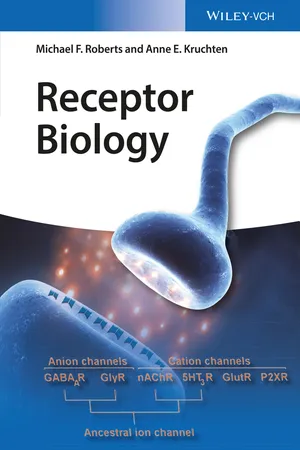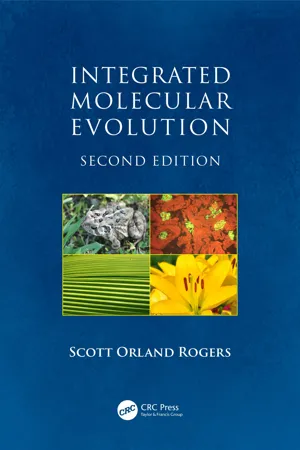Biological Sciences
Archaeplastida
Archaeplastida is a supergroup of eukaryotes that includes red algae, green algae, and land plants. It is characterized by the presence of chloroplasts derived from a primary endosymbiotic event involving a cyanobacterial ancestor. This group is significant in the evolutionary history of photosynthetic organisms and has had a major impact on the Earth's ecosystems.
Written by Perlego with AI-assistance
Related key terms
3 Key excerpts on "Archaeplastida"
- eBook - ePub
- Michael F. Roberts, Anne E. Kruchten(Authors)
- 2016(Publication Date)
- Wiley-VCH(Publisher)
Modified from Figure 2 of Ref. [358]. Used with permission.In two of these, the Archaeplastida (red/green algae and plants) and the Unikonta (amoebas, fungi, and animals), most members are multicellular and use complex developmental pathways to achieve the adult state. The remaining three major eukaryotic clades illustrate a primarily unicellular lifestyle. The Excavata (including the photosynthetic Euglena), the Chromalveolata (including the malaria-causing Plasmodium), and the Rhizaria (including the planktonic Foraminifera) all belong to major eukaryotic taxa that are unicellular.All major eukaryote taxa have flagella as part of their locomotive function; all but the Unikonta possess multiple flagella, and these are often arranged in the center of the cell or at the cell's anterior. This flagellar arrangement is important for understanding relationships among the various eukaryotic taxa.11.2.2.1 Chromalveolates – Generally Unicellular but with One Multicellular Clade
This group contains the multicellular brown algae, also known as kelp . It is instructive to mention the brown algae here because they develop from a zygote in a manner similar to that of plants, and some of the same hormones, discovered initially as plant hormones, are involved in defining algal developmental stages [359]. Thus, they exhibit some of the features considered to be important predictors of the cellular interactions required by multicellular organisms [360]. Although the kelp are called brown “algae,” they are not part of the large taxon including the true plants and red or green algae.11.2.2.2 Archaeplastida – Algae and Plants
Many members of the Archaeplastida share with the animals the appearance of being “multicellular.” The plants with which most people are familiar are complex multicellular organisms that have many cell types, tissue types, and organ - eBook - ePub
- Scott Orland Rogers(Author)
- 2016(Publication Date)
- CRC Press(Publisher)
By 1.2 billion years ago, some members of one line of the Archaeplastida had undergone changes in their photosynthetic and other cellular processes, becoming unicellular chlorophytes (green algae). Initially, most were unicellular, but soon thereafter several multicellular forms appeared. Some were essentially collections of identical or very similar cells, while in others more than one cell type developed (Figure 17.2). As the organisms evolved, the cell types became more differentiated from one another, taking on different roles in the body of the organism. For example, in some of the multicellular organisms, there were cells specialized in motility and orientation of the organism to optimize the amount of photosynthesis, while other cells performed the majority of the photosynthetic processes for the organism. One branch of the Chlorophyta diverged and led to the evolution of all other groups of the Archaeplastida, including the unicellular Prasinophyta (marine and freshwater planktonic algae), and the multicellular taxa from the Charophyta (freshwater green algae) to the Spermatopsida (seed plants, such as gymnosperms and angiosperms). Some unicellular rhodophytes and chlorophytes became endosymbionts, and later organelles, of several protist groups, including Chromalveolata (Chromista, Stramenopiles, and Hacrobians) and Excavata. Some of these groups diversified to produce unicellular and multicellular forms, including the brown algae, golden algae, yellow-green algae, diatoms, dinoflagellates, and others. Thus, the innovation of photosynthesis was transferred via horizontal gene transfer of entire genomes to other kingdoms of organisms. As the evolution of these lineages continued, the male and female gametes became more specialized and had different morphologies - eBook - ePub
Marine Macro- and Microalgae
An Overview
- F. Xavier Malcata, Isabel Sousa Pinto, A. Catarina Guedes(Authors)
- 2018(Publication Date)
- CRC Press(Publisher)
Chloroplasts, flagella, and mitochondria have descended from free-living prokaryotes; the chloroplasts derived from cyanophytes and the latter from true bacteria. When the Earth’s atmosphere already had oxygen, a primitive phagotrophic eukaryote with amoeboid movements incorporated an aerobic bacterium. It was not digested, and started functioning as a respiratory organelle (mitochondrion). As a result, the primitive eukaryote became aerobic. Later, this aerobic eukaryote incorporated another prokaryotic saprophyte, mobile by microtubules in a 9 + 2 arrangement. The incorporation was not total and the flagellum started acting as the host locomotion organelle, evolving later into the typical flagellum of eukaryotes. At about 1500 Ma ago, some of these heterotrophic flagellates incorporated a cyanobacterium (Palmer 2003; Keeling 2004) which was not digested and turned into a photosynthetic organelle (chloroplast), giving rise to the first photoautotrophic eukaryotes which subsequently gave rise to the various groups of algae and land plants.Three major eukaryotic photosynthetic groups (possessing primary plastids) have descended from a common prokaryotic ancestor, whereas the remaining algal groups have acquired their plastids via secondary or even tertiary endosymbiosis. The three major algal lineages with primary plastids are the Glaucophyta, the Rhodophyta, and the Chlorophyta. Multicellular green algae then successfully invaded the land environment and originated mosses, ferns, and vascular plants. Other algae underwent processes of secondary endosymbiosis (Keeling 2004), for example, green algae evolved into Euglenophyta and red originated the Chromalveolata, a diverse group of algae whose chloroplasts possess chlorophyll a and c, including the Cryptophyta, the Haptophyta (coccolitophoroids), the Ochrophyta (=Heterokontophyta), and the dinoflagellates.In this view, green algae and higher plants form a group having a common ancestor with the red algae, and the chloroplasts of brown algae resulted from a secondary endosymbiosis with a red alga. Although our understanding of the evolution of algae has improved in the last years, first by phylogenetic analyses of nuclear ribosomal sequence data (mainly 18S), and more recently by analyses of multi-gene and chloroplast genomic data, the phylogenetic relationships are still not well established (Fang et al. 2017).
Learn about this page
Index pages curate the most relevant extracts from our library of academic textbooks. They’ve been created using an in-house natural language model (NLM), each adding context and meaning to key research topics.


